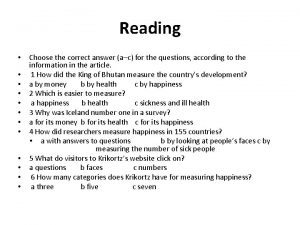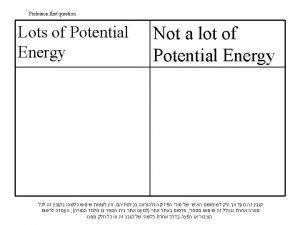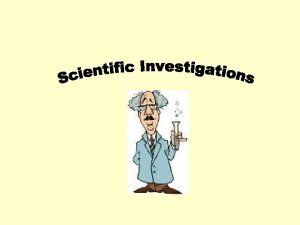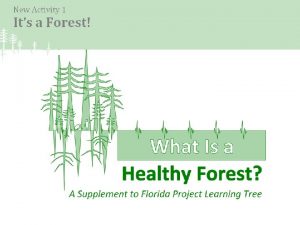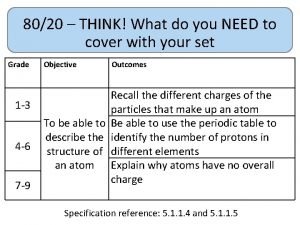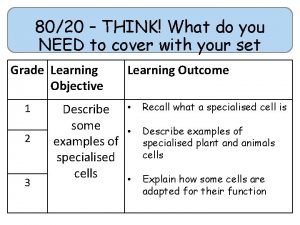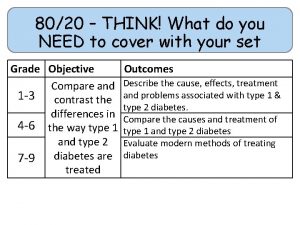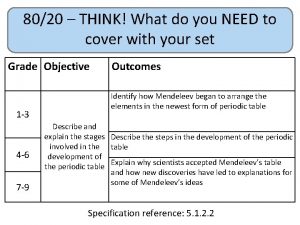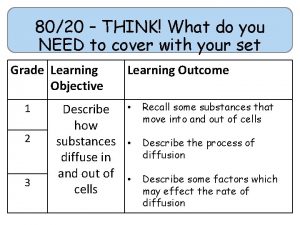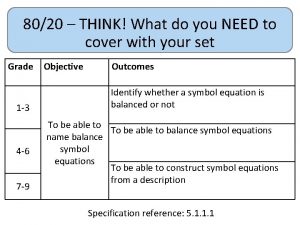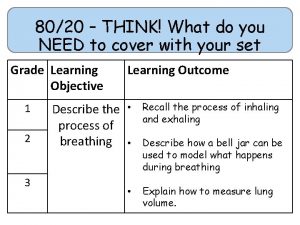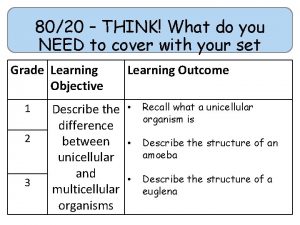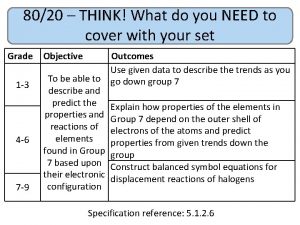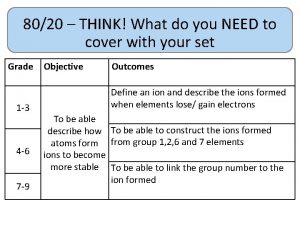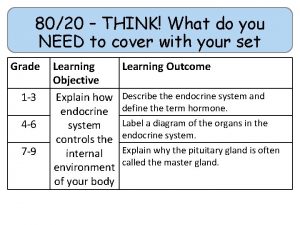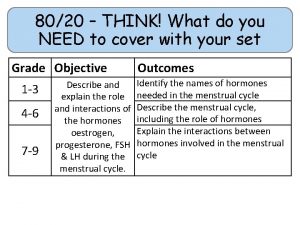8020 THINK What do you NEED to cover

















- Slides: 17

80/20 – THINK! What do you NEED to cover with your set Grade Learning Objective 1 2 3 Describe the gas exchange system in humans Learning Outcome • Recall the structure of the gas exchange system • Describe how parts of the gas exchange system are adapted to their function • Describe the composition of inhaled and exhaled air

Gas Exchange Do now activity: Place the following structures in order of size, smallest to largest. Muscle tissue Nerve cell Digestive System Lungs

Progress indicators GOOD PROGRESS: • Recall the structure of the gas exchange system • Describe how parts of the gas exchange system are adapted to their function OUTSTANDING PROGRESS: • Describe the composition of inhaled and exhaled air

When we breathe in, we take in oxygen from the air and when we breathe out, we release carbon dioxide. This process is called gas exchange and takes place in the lungs.

Memory Test: Spend three minutes studying this diagram, try to remember the location of each of the structures!

Memory Test: Spend three minutes trying to label the structures of the respiratory system!

How many did you get right?

Task: Watch the video and answer the following questions: https: //www. youtube. com/watch? v=yl. Ekn. Rf 0 j. LU 1. What is contained within the thorax? 2. What is the role of the trachea? 3. Describe the route an oxygen molecule travels as it moves through the lungs. 4. What are some special features of the alveoli?

Self-assessment: 1. The breathing apparatus 2. The trachea connects the mouth to the lungs, also known as the windpipe. 3. Oxygen is breathed in through the mouth, it then travels down the trachea, into the bronchioles and finally the alveoli. 4. Alveoli have a large surface area, moist, thin walls and a good blood supply.

Why do we breathe in and out? Think > Pair > Share 1. What is the name of the gas that we breathe in? 2. What is this gas used for, inside our bodies? 3. What is the name of the gas that breathe out?

Self-assessment: 1. We breathe in oxygen from the air. 2. Oxygen is used in a process called respiration; this releases energy that our bodies can than use. 3. Carbon dioxide is a waste gas that we breathe out.

Task: Complete the worksheet on the composition of inhaled and exhaled air. Self-assessment: 1. The percentage composition of nitrogen gas remains unchanged between inhaled and exhaled air. 2. The percentage composition of carbon dioxide gas is greater in exhaled air than it is in inhaled air. 3. The percentage composition of oxygen decreases from 21% to 15%, so a total of 6% from inhaled to exhaled air. 4. Oxygen passes through the alveoli wall and into the bloodstream, here is travels to cells where it is used in respiration to release energy.

Plenary: Exit Card Task: On a piece of paper write down: 3 things you have learnt today 5 key words 1 question to test your peers

Resources


Composition of Inhaled & Exhaled Air Gas Inhaled Air (%) Exhaled Air (%) Nitrogen 78 78 Oxygen 21 16 Carbon Dioxide 0. 04 5. 04 Other gases 0. 96 1. Name a gas whose composition in the air remains unchanged between inhaled and exhaled air. 2. Name a gas whose composition increases in exhaled air. 3. Calculate by how much the composition of oxygen decreases between inhaled and exhaled air. 4. Explain what happens to the oxygen that has been removed from inhaled air.

Nose Mouth Bronchioles Ribcage Alveoli Muscle Lungs Heart Diaphragm
 Iso 8020
Iso 8020 Think big think fast think ahead
Think big think fast think ahead If you think you can you can poem
If you think you can you can poem Latent strabismus
Latent strabismus Intermittent exotropia
Intermittent exotropia Harmonious arc
Harmonious arc I wish you strenght
I wish you strenght New speaker new line worksheet
New speaker new line worksheet Think said the robin
Think said the robin Think family ni
Think family ni So you think you can argue
So you think you can argue Choose the correct answers a-c what do you think
Choose the correct answers a-c what do you think So you think you can argue
So you think you can argue Minecraft did you know
Minecraft did you know What comes to mind when you hear the word 'family'?
What comes to mind when you hear the word 'family'? You have more potential than you think
You have more potential than you think What do you think of when you hear the word science?
What do you think of when you hear the word science? What do you think of when you hear
What do you think of when you hear











